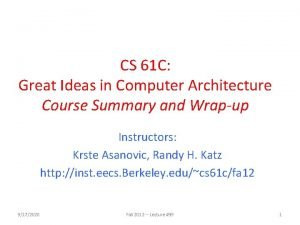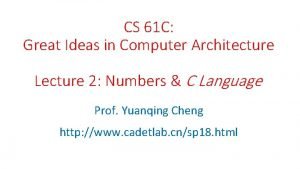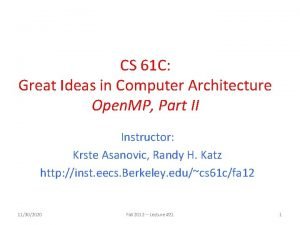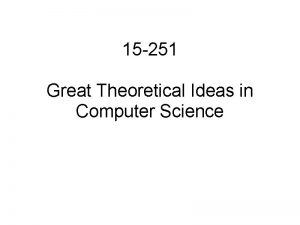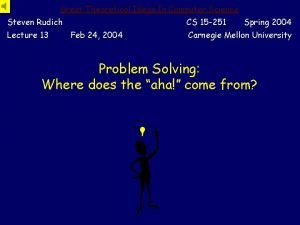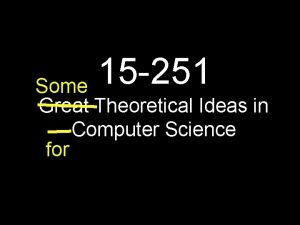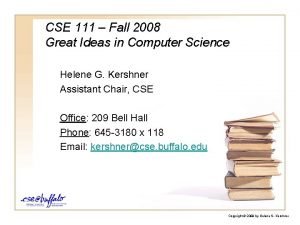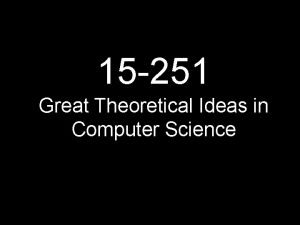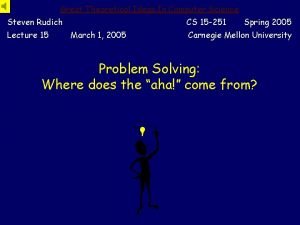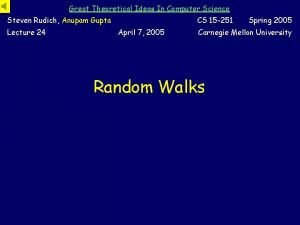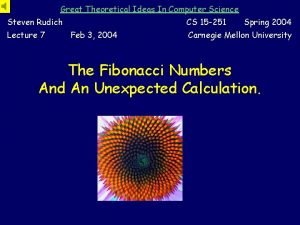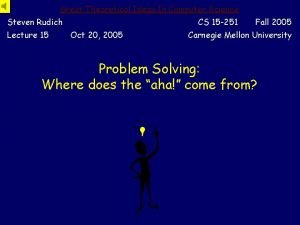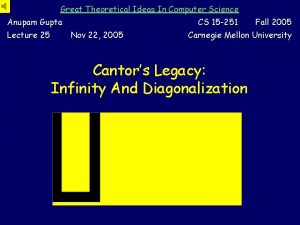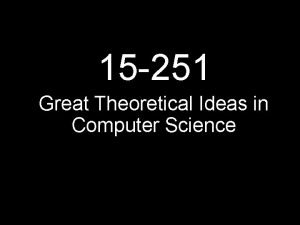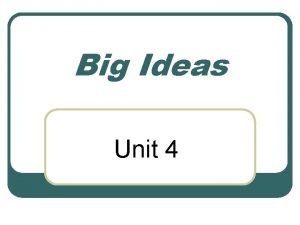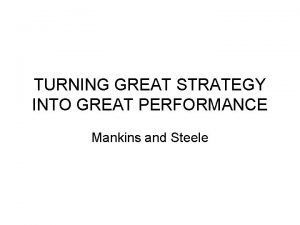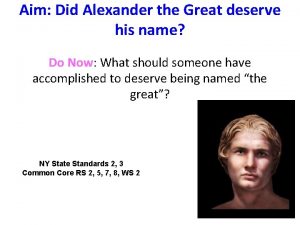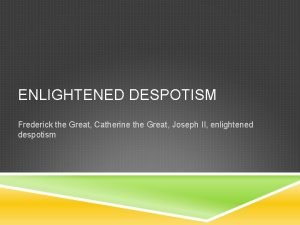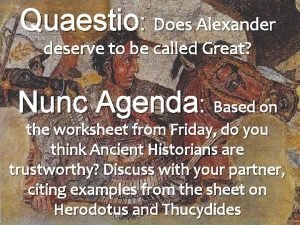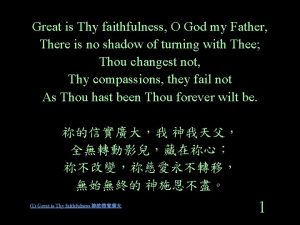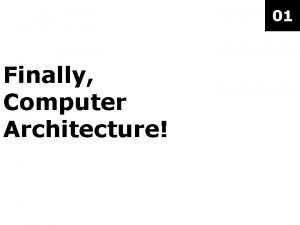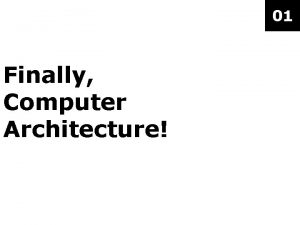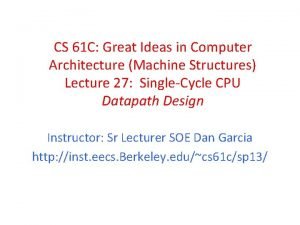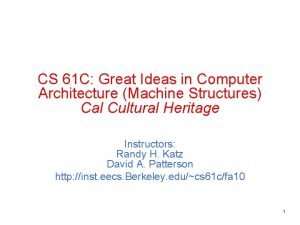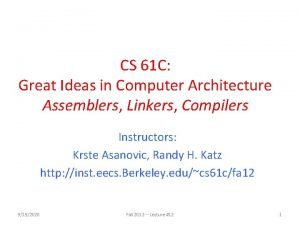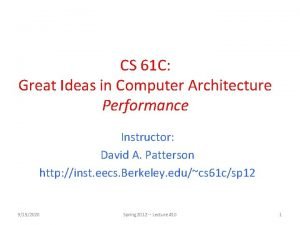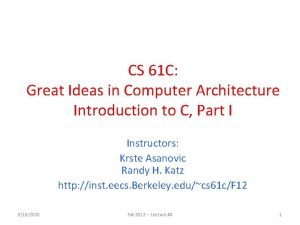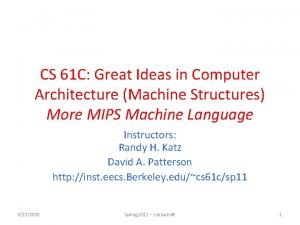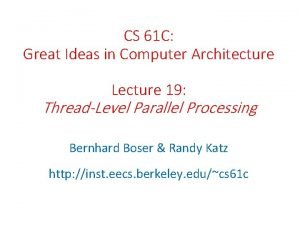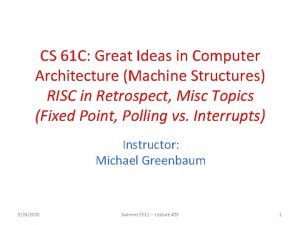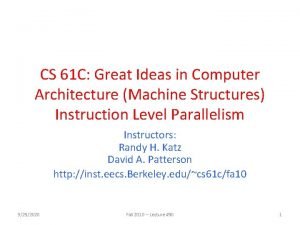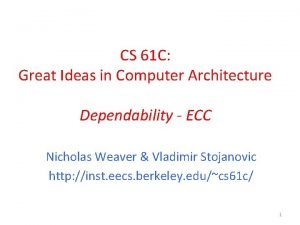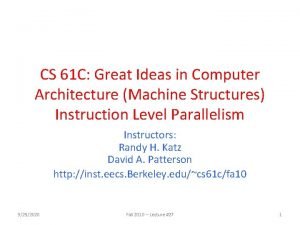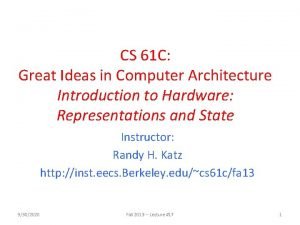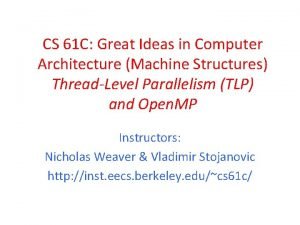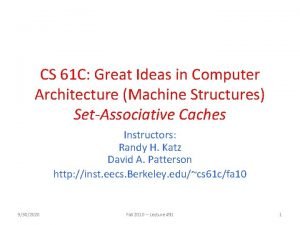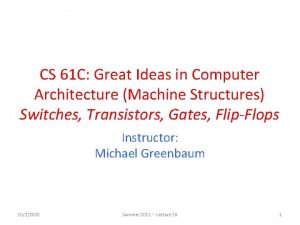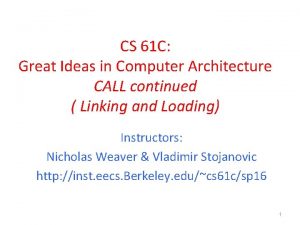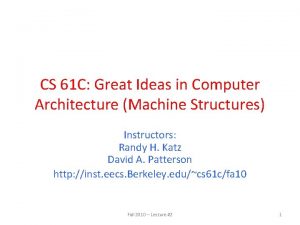CS 61 C Great Ideas in Computer Architecture
























![Actual C Code #include <stdio. h> #define REPEAT 5 int main(int argc, char *argv[]) Actual C Code #include <stdio. h> #define REPEAT 5 int main(int argc, char *argv[])](https://slidetodoc.com/presentation_image/6aace50760e6c3aa56963c486ee08851/image-25.jpg)




















- Slides: 45

CS 61 C: Great Ideas in Computer Architecture (Machine Structures) Introduction to C (Part I) Instructor: Michael Greenbaum http: //inst. eecs. Berkeley. edu/~cs 61 c/su 1 1 9/25/2020 Spring 2011 -- Lecture #3 1

Two’s Complement Review • Suppose we had 5 bits. What integers can be represented in two’s complement? a) -32 to +31 b) -31 to +32 c) 0 to +31 d) -16 to +15 e) -15 to +15 f) -15 to +16 9/25/2020 Spring 2011 -- Lecture #7 2

Two’s Complement Review • Suppose we had 5 bits. What integers can be represented in two’s complement? a) -32 to +31 b) -31 to +32 c) 0 to +31 d) -16 to +15 e) -15 to +15 f) -15 to +16 9/25/2020 Spring 2011 -- Lecture #7 3

Agenda • • • Scheme vs. Java vs. C Administrivia Quick Start Introduction to C Break Pointers Summary 9/25/2020 Spring 2011 -- Lecture #3 4

Levels of Representation/Interpretation High Level Language Program (e. g. , C) Compiler Assembly Language Program (e. g. , MIPS) Assembler Machine Language Program (MIPS) temp = v[k]; v[k] = v[k+1]; v[k+1] = temp; lw lw sw sw 0000 1010 1100 0101 $t 0, 0($2) $t 1, 4($2) $t 1, 0($2) $t 0, 4($2) 1001 1111 0110 1000 1100 0101 1010 0000 We are here! Anything can be represented as a number, i. e. , data or instructions 0110 1000 1111 1001 1010 0000 0101 1100 1111 1000 0110 0101 1100 0000 1010 1000 0110 1001 1111 Machine Interpretation Hardware Architecture Description (e. g. , block diagrams) Architecture Implementation Logic Circuit Description (Circuit Schematic Diagrams)Spring 2011 -- Lecture #3 9/25/2020 5

Agenda • • • C Language Overview Administrivia C Syntax and Control Flow Break Pointers Summary 9/25/2020 Spring 2011 -- Lecture #3 6

Introduction to C • Official prerequisites: “Some” C experience is required before CS 61 C C++ or Java OK • Spring 2011 statistics – – – 83% already know JAVA 54% already know C++ 34% already know C 7% already know C# About 10% have not taken 61 B or equivalent • If you have no experience in these languages, then start early and ask a lot of questions in discussion! 9/25/2020 Spring 2011 -- Lecture #3 7

Disclaimer • You will not learn how to fully code in C in these lectures! You’ll still need your C reference for this course – K&R is a must-have • Check online for more sources – “Brian Harvey’s helpful transition notes • On CS 61 C class website • http: //inst. eecs. berkeley. edu/~cs 61 c/resources/Harvey. Note s. C 1 -3. pdf • Key C concepts: Pointers, Arrays, Implications for Memory management 9/25/2020 Spring 2011 -- Lecture #3 8

C vs. Java C Java Type of Language Function Oriented Object Oriented Programming Unit Function Class / Abstract Data Types Compilation Machine dependant assembly Machine independent bytecode Execution Loads and executes program JVM interprets bytecode hello, world #include<stdio. h> int main(void) { printf("Hellon"); return 0; } public class Hello. World { public static void main(String[] args) { System. out. printl("Hello"); } } Memory Manual (malloc, free) Automatic (garbage collection) management 9/25/2020 Fall 2010 -- Lecture #1 From http: //www. cs. princeton. edu/introcs/faq/c 2 java. html 9

Compilation: Overview • C compilers map C programs into architecturespecific machine code (string of 1 s and 0 s) – Unlike Java, which converts to architecture independent bytecode – Unlike most Scheme environments, which interpret the code – These differ mainly in exactly when your program is mapped to low-level machine instructions – For C, generally a two part process of compiling. c files to. o files, then linking the. o files into executables; Assembling is also done (but is hidden, i. e. , done automatically, by default) 9/25/2020 Spring 2011 -- Lecture #3 10

Compilation: Advantages • Excellent run-time performance: generally much faster than Scheme or Java for comparable code (because it optimizes for a given architecture) • Fair compilation time: enhancements in compilation procedure (Makefiles) allow only modified files to be recompiled • Why C? : we can write programs that allow us to exploit underlying features of the architecture – memory management, special instructions, parallelism 9/25/2020 Spring 2011 -- Lecture #3 11

Compilation: Disadvantages • Compiled files, including the executable, are architecture-specific, depending on CPU type and the operating system • Executable must be rebuilt on each new system – I. e. , “porting your code” to a new architecture • “Change Compile Run [repeat]” iteration cycle can be slow, during the development cycle 9/25/2020 Spring 2011 -- Lecture #3 12

Typed Variables in C int x = 2; float y = 1. 618; char z = 'A'; Type int short int (short) long int (long) char float double • You have to declare the type of data a variable will hold Description signed integer smaller signed integer larger signed interger single text character or symbol floating point non-integer numbers greater precision FP number Examples 5, -12, 0 'a', 'D', '? ’ 0. 0, 1. 618, -1. 4 • Integer sizes are machine dependant! • Common size is 4 bytes, but can’t ever assume this. • Can add “unsigned” before int or char type for unsigned • eg unsigned int 9/25/2020 Spring 2011 -- Lecture #3 13

Characters • How do we encode characters? • Relevant question: How many different characters do we want to encode? – ‘a’-’z’, ‘A-Z’, ‘ 0 -9’. – What else? 9/25/2020 Spring 2011 -- Lecture #3 14

Characters • ASCII standard – 128 different characters and their numeric encodings. – A char representing the character ‘a’ contains 97. – char c = ‘a’; or char c = 97 are both valid • 7 bits is enough to store a char (27 = 128), round up to 1 byte since computers usually only deal with multiples of bytes. 9/25/2020 Spring 2011 -- Lecture #3 15

Big Idea – Bits can represent anything! • Say we have 0 b 0110 0011 – Interpret it as a char – ‘c’ – Interpret it as a (signed or unsigned) integer: 99 • 0 b 1111 – Interpret it as a char: (not a valid char) – Interpret it as a signed int: -1 – Interpret it as an unsigned int: 255 • It all depends on how the programmer looks at them. • Just wait until Lecture 8, MIPS Instruction Formats, for an incredible example of this. 9/25/2020 Spring 2011 -- Lecture #3 16

Types in C • C is a “weakly” typed language. You can explicitly typecast from any type to any other. – int i = -1; if(i < 0) if((unsigned int) i < 0) printf(“This will printn”); printf(“This will not printn”); • Can be seen as changing the “programmer’s perspective” of the variable. • Can typecast anything, even if it doesn’t really make sense: – struct node n; //We will see structs in a few slides int i = (int) n; – More freedom, but easier to shoot yourself in the foot. 9/25/2020 Spring 2011 -- Lecture #3 17

Typed Functions in C //Function prototypes int multiply(int, int); void say. Hello(); int multiply(int x, int y) { return x*y; } void say. Hello () { printf(“Hellon”); } 9/25/2020 • You have to declare the type of data you plan to return from a function • Return type can be any C variable type, and is placed to the left of the function name • You can also specify the return type as void – Just think of this as saying that no value will be returned • Also necessary to define types for values passed into a function • Declaring the “prototype” of a function allows you to use it before the function’s definition. Spring 2011 -- Lecture #3 18

C Syntax: True or False • What evaluates to FALSE in C? – 0 (integer) – NULL (a special kind of pointer: more on this later) – No explicit Boolean type • What evaluates to TRUE in C? – Anything that isn’t false is true – Same idea as in scheme: only #f is false, anything else is true! 9/25/2020 Spring 2011 -- Lecture #3 19

Structs in C • Way of defining compound data types. • A structured group of variables, possibly including other structs typedef struct { int length. In. Seconds; int year. Recorded; } Song; Song song 1; song 1. length. In. Seconds = 213; song 1. year. Recorded = 1994; Song song 2; song 2. length. In. Seconds = 248; song 2. year. Recorded = 1988; 9/25/2020 Spring 2011 -- Lecture #3 20

Consts and Enums in C • Constant is assigned a value once in the declaration; value can't change until the program is restarted const float golden. Ratio = 1. 618; const int days. In. Week = 7; • You can have a constant version of any of the standard C variable types • Enums: a group of related constants used to parameterize libraries 9/25/2020 Spring 2011 -- Lecture #3 21

Agenda • • • C Language Overview Administrivia C Syntax and Control Flow Break Pointers Summary 9/25/2020 Spring 2011 -- Lecture #3 22

Administrivia • TA office hours have been decided. For this week – Justin – Th 1 -2, F 11 -12. Alcoves – Sean – W 3 -4, Th 11 -12. Moore room – 2 nd floor cory courtyard. – Alvin – MW 12 -1. Alcoves • HW 1 will be posted today. 9/25/2020 Spring 2011 -- Lecture #3 23

Agenda • • • C Language Overview Administrivia C Syntax and Control Flow Break Pointers Summary 9/25/2020 Spring 2011 -- Lecture #3 24
![Actual C Code include stdio h define REPEAT 5 int mainint argc char argv Actual C Code #include <stdio. h> #define REPEAT 5 int main(int argc, char *argv[])](https://slidetodoc.com/presentation_image/6aace50760e6c3aa56963c486ee08851/image-25.jpg)
Actual C Code #include <stdio. h> #define REPEAT 5 int main(int argc, char *argv[]) { int i; int n = 5; for (i = 0; i < REPEAT; i = i + 1) { printf("hello, worldn"); } return 0; }

C Syntax: main • To get arguments to the main function, use: – int main (int argc, char *argv[]) • What does this mean? – argc contains the number of strings on the command line (the executable counts as one, plus one for each argument). Here argc is 2: unix% sort my. File – argv is a pointer to an array containing the arguments as strings (more on pointers later) 9/25/2020 Spring 2011 -- Lecture #3 26

C Syntax: Variable Declarations • Similar to Java, but with a few minor but important differences • All variable declarations must appear before they are used (e. g. , at the beginning of the block) • A variable may be initialized in its declaration; if not, it holds garbage! • Examples of declarations: – Correct: { int a = 0, b = 10; . . . − Incorrect: for (int i = 0; i < 10; i++) } 9/25/2020 Spring 2011 -- Lecture #3 27

C Syntax : Flow Control (1/2) • Within a function, remarkably close to Java constructs in methods (shows its legacy) in terms of flow control – if-else • if (expression) statement 1 else statement 2 – while • while (expression) statement • do statement while (expression); 9/25/2020 Spring 2011 -- Lecture #3 28

C Syntax : Flow Control (2/2) – for • for (initialize; check; update) statement – switch • switch (expression){ case const 1: statements case const 2: statements default: statements } • break 9/25/2020 Spring 2011 -- Lecture #3 29

Agenda • • • Scheme vs. Java vs. C Administrivia Quick Start Introduction to C Technology Break Pointers 9/25/2020 Spring 2011 -- Lecture #3 30

Agenda • • • Scheme vs. Java vs. C Administrivia Quick Start Introduction to C Technology Break Pointers 9/25/2020 Spring 2011 -- Lecture #3 31

Address vs. Value • Consider memory to be a single huge array – Each cell of the array has an address associated with it – Each cell also stores some value – Do you think they use signed or unsigned numbers? Negative address? ! • Don’t confuse the address referring to a memory location with the value stored there. . . 9/25/2020 101 102 103 104 105. . . 23 42 Spring 2011 -- Lecture #3 . . . 32

Pointers • An address refers to a particular memory location; e. g. , it points to a memory location • Pointer: A variable that contains the address of a variable Location (address) . . . 101 102 103 104 105. . . 23 42 x y 104 . . . p name 9/25/2020 Spring 2011 -- Lecture #3 33

Pointers • How to create a pointer: (& operator: get address of a variable ) int *p, x; x = 3; p = &x; p ? x ? p ? x 3 p Note the “*” gets used 2 different ways in this example. In the declaration to indicate that p is going to be a pointer, and in the printf to get the value pointed to by p. • How get a value pointed to? * “dereference operator”: get the value that the pointer points to printf(“p points to %dn”, *p); 9/25/2020 Spring 2011 -- Lecture #3 34

Pointers • How to change a variable pointed to? – Use the dereference operator * on left of assignment operator = *p = 5; 9/25/2020 p x 3 p x 5 Spring 2011 -- Lecture #3 35

Pointers and Parameter Passing • Java and C pass parameters “by value” – Procedure/function/method gets a copy of the parameter, so changing the copy cannot change the original void add. One (int x) { x = x + 1; } int y = 3; add. One(y); y remains equal to 3 9/25/2020 Spring 2011 -- Lecture #3 36

Pointers and Parameter Passing • How can we get a function to change a value? void add. One (int *p) { *p = *p + 1; } int y = 3; add. One(&y); y is now equal to 4 9/25/2020 Spring 2011 -- Lecture #3 37

Pointers • Pointers are used to point to any kind of data (int, char, a struct, etc. ) • Normally a pointer only points to one type (int, char, a struct, etc. ). – void * is a type that can point to anything (generic pointer) – Use sparingly to help avoid program bugs, and security issues, and other bad things! 9/25/2020 Spring 2011 -- Lecture #3 38

Peer Instruction Question void main(); { int *p, x=5, y; // init y = *(p = &x) + 1; int z; flip-sign(p); printf("x=%d, y=%d, p=%dn", x, y, p); } flip-sign(int *n){*n = -(*n)} How many syntax + logic errors in this C code? 9/25/2020 Spring 2011 -- Lecture #3 #Errors a) 1 b) 2 c) 3 d) 4 e) >4 39

Peer Instruction Answer #include <stdio. h> void main(); { int *p, x=5, y; // init y = *(p = &x) + 1; int z; flip-sign(p); printf("x=%d, y=%d, p=%dn", x, y, *p); } flip-sign(int *n){*n = -(*n); } #Errors a) 1 a)1 How many syntax + logic b) 2 b)2 errors in this C code? c) 3 c)3 SIX d) 4 d)4 e) >4 e)5 9/25/2020 Spring 2011 -- Lecture #3 40

More C Pointer Dangers • Declaring a pointer just allocates space to hold the pointer – it does not allocate thing being pointed to! • Local variables in C are not initialized, they may contain anything (aka “garbage”) • What does the following code do? void f() { int *ptr; *ptr = 5; } 9/25/2020 Spring 2011 -- Lecture #3 41

Pointers in C • Why use pointers? – If we want to pass a large struct or array, it’s easier / faster / etc. to pass a pointer than the whole thing – In general, pointers allow cleaner, more compact code • So what are the drawbacks? – Pointers are probably the single largest source of bugs in C, so be careful anytime you deal with them • Most problematic with dynamic memory management— which you will to know by the end of the semester, but not for the projects (there will be a lab later in the semester) • Dangling references and memory leaks 9/25/2020 Spring 2011 -- Lecture #3 42

Why Pointers in C? • At time C was invented (early 1970 s), compilers often didn’t produce efficient code – Computers 25, 000 times faster today, compilers better • C designed to let programmer say what they want code to do without compiler getting in way – Even give compilers hints which registers to use! • Today’s compilers produce much better code, so may not need to use pointers – Compilers even ignore hints since they do it better! 9/25/2020 Fall 2010 -- Lecture #3 43

Has there been an update to ANSI C? • Yes! It’s called the “C 99” or “C 9 x” std – You need “gcc -std=c 99” to compile • References http: //en. wikipedia. org/wiki/C 99 http: //home. tiscalinet. ch/t_wolf/tw/c/c 9 x_changes. html • Highlights – – – Declarations in for loops, like Java (#15) Java-like // comments (to end of line) (#10) Variable-length non-global arrays (#33) <inttypes. h>: explicit integer types (#38) <stdbool. h> for boolean logic def’s (#35)

And In Conclusion, … • Bits can represent anything! – chars, integers, floating point, … • C is an efficient language, but leaves safety to the programmer – Weak type safety – Variables not automatically initialized – Use pointers with care: they are a common source of bugs in programs • All data is in memory – Each memory location has an address to use to refer to it and a value stored in it • Pointer is a C version (abstraction) of a data address – * “follows” a pointer to its value – & gets the address of a value – Arrays and strings are implemented as variations on pointers 9/25/2020 Spring 2011 -- Lecture #3 45
 Eight ideas in computer architecture
Eight ideas in computer architecture 8 great ideas in computer architecture
8 great ideas in computer architecture 8 great ideas in computer architecture
8 great ideas in computer architecture 8 great ideas in computer architecture
8 great ideas in computer architecture Great theoretical ideas in computer science
Great theoretical ideas in computer science Great theoretical ideas in computer science
Great theoretical ideas in computer science Great theoretical ideas in computer science
Great theoretical ideas in computer science Great ideas in computer science
Great ideas in computer science 15 251
15 251 Great theoretical ideas in computer science
Great theoretical ideas in computer science Great theoretical ideas in computer science
Great theoretical ideas in computer science Steven rudich
Steven rudich Great theoretical ideas in computer science
Great theoretical ideas in computer science Great theoretical ideas in computer science
Great theoretical ideas in computer science Great theoretical ideas in computer science
Great theoretical ideas in computer science Bus design in computer architecture
Bus design in computer architecture Computer organization and architecture difference
Computer organization and architecture difference Complete computer description in computer organization
Complete computer description in computer organization Ideas have consequences bad ideas have victims
Ideas have consequences bad ideas have victims Ideas secundarias
Ideas secundarias Unit 4 great ideas
Unit 4 great ideas Turning great strategy into great performance
Turning great strategy into great performance Great faces great places
Great faces great places Leadership comes with great responsibility
Leadership comes with great responsibility Great white shark versus hammerhead shark
Great white shark versus hammerhead shark Did alexander the great deserve to be called great
Did alexander the great deserve to be called great Frederick the great catherine the great enlightened despot
Frederick the great catherine the great enlightened despot With great expectations comes great responsibility
With great expectations comes great responsibility A great deal vs a great many
A great deal vs a great many With great power comes great responsibility
With great power comes great responsibility Does alexander deserve to be called the great
Does alexander deserve to be called the great Oh god my father how great great is your faithfulness
Oh god my father how great great is your faithfulness What is architecture business cycle?
What is architecture business cycle? Call and return architecture
Call and return architecture Product architecture example
Product architecture example Integral product architecture example
Integral product architecture example Computer organization and architecture 10th solution
Computer organization and architecture 10th solution Intel pentium
Intel pentium Iit kharagpur virtual lab coa
Iit kharagpur virtual lab coa Introduction to computer organization and architecture
Introduction to computer organization and architecture Timing and control in computer architecture
Timing and control in computer architecture Computer architecture: concepts and evolution
Computer architecture: concepts and evolution Dma controller in computer architecture
Dma controller in computer architecture Fp adder
Fp adder Addressing mode in computer architecture
Addressing mode in computer architecture Chordal ring
Chordal ring

